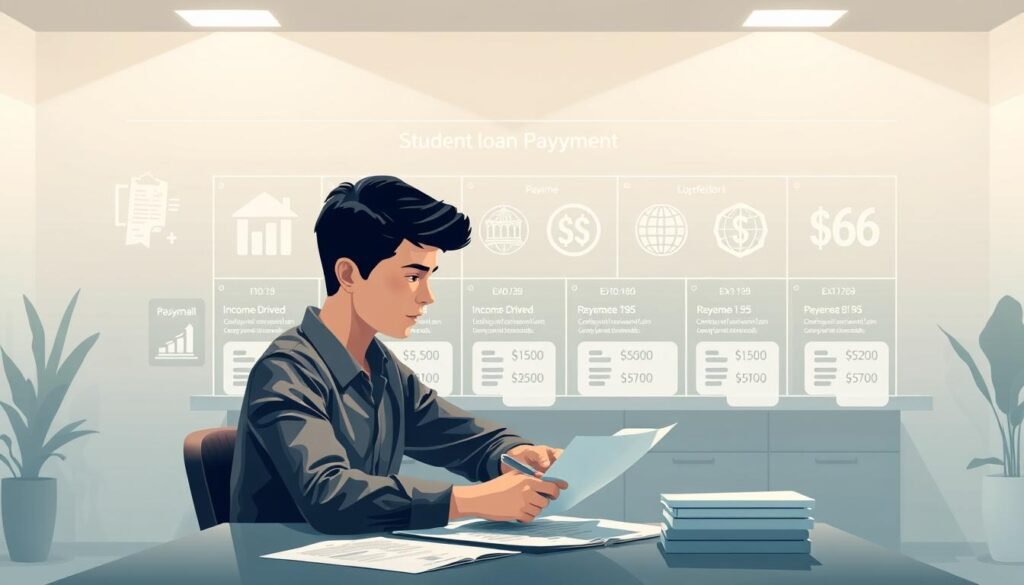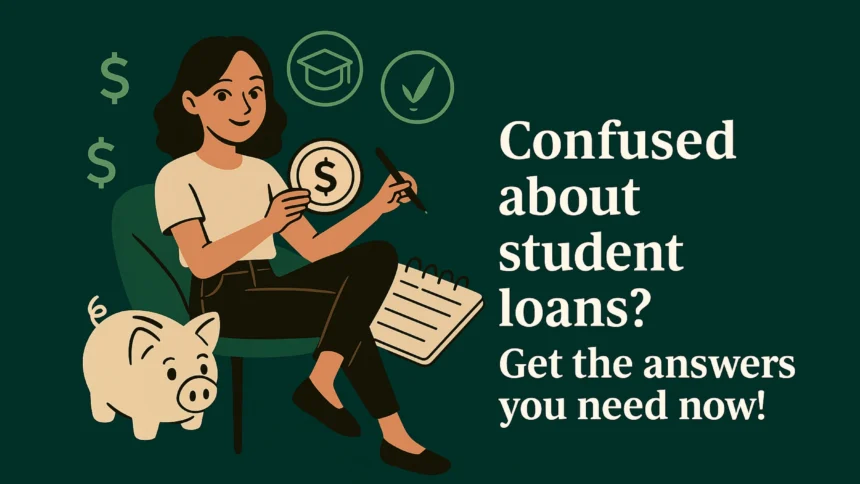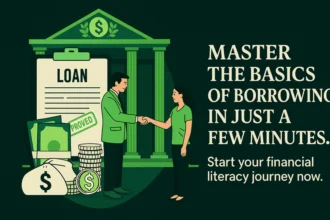Nearly 44 million Americans are burdened with student loan debt, a total exceeding $1.7 trillion. This figure underlines the importance of grasping the student loan definition and comprehending their operational mechanisms.
A student loan serves as a financial resource, intended to alleviate the financial strain associated with educational pursuits. These loans are extended to students to facilitate the payment of tuition fees, living expenses, and other costs directly linked to their academic endeavors.
Key Takeaways
- Student loans are financial aids for students to cover education expenses.
- These loans help students pay for tuition fees, living expenses, and other education-related costs.
- Understanding student loan definitions is essential for effective debt management.
- Student loans can be categorized as federal or private, each with its own set of terms and conditions.
- Repayment options are diverse, encompassing income-driven repayment plans.
Understanding Student Loans
The realm of student loans is intricately complex, necessitating a foundational comprehension to facilitate informed decision-making. These financial instruments are crafted to alleviate the economic burden of higher education, encompassing tuition fees and living expenses.
Grasping the intricacies of how student loans work reveals that they are not merely loans; they are accompanied by a plethora of stipulations, including interest rates that can profoundly influence the total repayment amount. Interest rates dictate the additional financial burden beyond the principal sum borrowed.
Student loans are predominantly categorized into two interest rate types: fixed and variable. Fixed interest rates persist unchanged throughout the loan’s duration, ensuring repayment predictability. In contrast, variable interest rates fluctuate, potentially altering monthly payments.
Appreciating the implications of these interest rates is imperative. A minor variation in interest rates can precipitate significant financial repercussions, either through savings or increased costs over the loan’s lifespan. Recent studies indicate that a mere 1% difference in interest rates can yield substantial variations in total repayment amounts. For a deeper exploration of how interest rate fluctuations can impact student loan payments, refer to this article that examines the possible escalation of student loan payments.
The assignment of interest rate type is contingent upon the loan’s nature. Federal student loans typically offer fixed interest rates, whereas private lenders may provide both fixed and variable rates.
- Fixed interest rates ensure repayment stability.
- Variable interest rates may offer initial rate advantages but carry the risk of future rate increases.
- Comprehensive loan terms understanding is vital for effective debt management.
By comprehending the foundational aspects of how student loans work and the subtleties of student loan interest rates, borrowers can make more astute financial decisions. This can lead to cost savings and the avoidance of unnecessary debt.
Types of Student Loans Available
The landscape of financing higher education is complex, with a plethora of types of student loans to navigate. Students and their families must consider a variety of options, each with its own set of advantages and disadvantages.
The dichotomy between federal and private student loans is fundamental. Federal student loans, backed by the government, offer more favorable terms, including lower interest rates and flexible repayment schedules. These loans are often subsidized, with the government absorbing the interest during the student’s academic tenure.
In contrast, private student loans are provided by financial institutions such as banks and credit unions. While they may present competitive interest rates, they necessitate a credit check and often come with less advantageous repayment terms compared to federal loans.
Federal Student Loan Options
- Direct Subsidized Loans: These are accessible to undergraduate students demonstrating financial need. The government covers the interest during the student’s academic period.
- Direct Unsubsidized Loans: Available to both undergraduate and graduate students, regardless of financial need. Interest accrues during the student’s academic tenure.
- PLUS Loans: Designed for graduate students or parents of undergraduate students. They require a credit check.
Private Student Loan Considerations
Private student loans serve as a financial bridge when federal aid is insufficient. They are often characterized by variable interest rates and less robust consumer protection. It is imperative to meticulously review the student loan application process for private loans, as they may necessitate a co-signer and offer different deferment options.
In summary, comprehending the diverse types of student loans is critical for making well-informed decisions regarding higher education financing. By carefully evaluating the pros and cons of federal and private loans, students can select the most suitable option for their financial circumstances and academic aspirations.
How Student Loans Work
Grasping the intricacies of student loans is imperative for those in pursuit of educational financing. The journey commences with assessing one’s eligibility and culminates in the repayment phase. Each step is critical, forming the backbone of the financial aid system.
Applying for Federal Student Loans
The initial step towards securing federal student loans is the completion of the Free Application for Federal Student Aid (FAFSA). This application is instrumental in ascertaining a student’s eligibility for various forms of financial assistance.
The FAFSA necessitates the disclosure of extensive financial details, encompassing income, assets, and demographic specifics. Prospective applicants are advised to compile the requisite documents, including tax returns and social security numbers, in advance.
Upon submission of the FAFSA, the student’s financial profile is analyzed, resulting in the computation of an Expected Family Contribution (EFC). This figure serves as a benchmark for colleges to gauge a student’s eligibility for federal loans and other financial aid packages.
- Students are encouraged to list all prospective colleges on the FAFSA.
- Colleges will then construct a financial aid package based on the FAFSA data.
- Students will receive a financial aid award letter detailing the types and amounts of aid they qualify for.
By comprehending the application process for federal student loans, students can adeptly navigate the complexities of financial aid. This knowledge empowers them to make well-informed decisions regarding their educational financing.
Eligibility Requirements for Student Loans
Grasping the eligibility criteria for student loans is imperative for students in pursuit of financial assistance. To be eligible for a student loan, applicants must fulfill specific standards established by the lender or the federal government.
The eligibility standards for federal student loans are typically more straightforward than those for private loans. For federal loans, students generally must be enrolled at least half-time in a degree-granting program, be a U.S. citizen or eligible non-citizen, and uphold satisfactory academic progress.
Key Eligibility Factors for Federal Student Loans:
- Enrollment status: Students must be enrolled at least half-time.
- Citizenship status: Applicants must be U.S. citizens or eligible non-citizens.
- Academic progress: Students must maintain satisfactory academic progress.
- Financial need: Some federal loans require demonstrating financial need.
Private student loans, conversely, exhibit diverse eligibility criteria based on the lender. These may encompass credit score, income, and enrollment status. Certain private lenders may necessitate a co-signer.
To enhance their approval prospects, students should meticulously review the eligibility criteria before applying. This entails comprehending the student loan application process and compiling necessary documents, such as proof of income and enrollment.
By adhering to the eligibility requirements and navigating the application process, students can attain the financial support necessary to advance their educational endeavors.
The Impact of Student Loans on College Students
Student loans exert a profound influence on the financial stability and academic performance of collegiate students. The financial strain imposed by these loans can precipitate significant stress, impacting students’ overall well-being and their capacity to excel academically.
The psychological implications of student loan debt extend beyond mere financial concerns. Students burdened with substantial debt may experience overwhelming feelings, leading to anxiety and depression. This stress can divert their attention from their studies, potentially undermining their academic achievements.
Financial Burden: The immediate financial strain of student loans often compels students to engage in part-time employment, potentially diverting their focus from academic pursuits. The obligation to repay these loans post-graduation can also delay significant life milestones, such as homeownership or family establishment.
Academic Performance: Studies indicate that students with higher debt levels may select majors based on salary prospects, potentially leading to career dissatisfaction. This can result in a less fulfilling academic journey.
To counteract these effects, it is imperative for students to comprehend their loan options and borrow judiciously. Financial literacy is critical in effectively managing student loan debt. Students must be well-versed in the terms of their loans, including interest rates and repayment conditions.
- Understand the total cost of the loan
- Explore income-driven repayment plans
- Consider loan forgiveness programs
- Seek financial counseling
By proactively addressing these issues, students can reduce the impact of student loans on their collegiate experience. It is equally important for educational institutions to offer resources and support to assist students in navigating the complexities of student loan debt.
Repaying Student Loans

The intricacies of student loan repayment necessitate a nuanced approach, with the adoption of efficacious strategies being imperative for debt management. A thorough comprehension of the student loan repayment options available is essential for borrowers to make informed decisions regarding their financial trajectory.
Income-Driven Repayment Plans
Income-Driven Repayment (IDR) plans represent a critical avenue for repaying student loans. These plans dynamically adjust the borrower’s monthly payment to align with their income and family size, facilitating a more sustainable repayment regimen for those facing financial adversity.
- Income-Based Repayment (IBR) Plan: Caps monthly payments at a percentage of discretionary income.
- Pay As You Earn (PAYE) Plan: Offers reduced monthly payments for eligible borrowers with high debt relative to income.
- Revised Pay As You Earn (REPAYE) Plan: Available to a broader range of borrowers, with payments based on income and family size.
For a more detailed exploration of these plans, borrowers are encouraged to consult personal finance resources that offer insights into the management of student loan debt.
Concomitantly, borrowers should investigate student loan forgiveness programs. Programs such as Public Service Loan Forgiveness (PSLF) provide loan forgiveness to borrowers engaged in public service roles after fulfilling a stipulated number of qualifying payments.
To optimize the benefits of these repayment options, borrowers are advised to:
- Assess their financial situation to determine the most suitable repayment plan.
- Stay informed about changes in loan policies and forgiveness programs.
- Consider consolidating loans to simplify repayment, if necessary.
By grasping and leveraging these student loan repayment options, borrowers can adeptly navigate the complexities of student loan debt, ultimately striving towards financial stability.
Common Myths About Student Loans
Student loan misconceptions can engender confusion and suboptimal financial planning among students and their families. It is imperative to distinguish between verifiable facts and unfounded myths to facilitate informed decisions regarding the financing of higher education.
One widespread myth posits that student loans are exclusively for those unable to afford college. Yet, numerous students from middle-class backgrounds also rely on student loans to meet educational expenses. In reality, the majority of students receive financial aid, including loans, to support their educational pursuits.
Another misconception is that all student loans are indistinguishable. In fact, there are substantial disparities between federal and private student loans, encompassing varying interest rates, repayment terms, and borrower protections. Federal loans, for instance, frequently offer more adaptable repayment options and forgiveness programs compared to their private counterparts.
Some individuals harbor the belief that student loans represent a poor investment. Contrarily, empirical evidence indicates that individuals with a college degree generally earn more than those without one. While acknowledging the substantial nature of student loan debt, the long-term advantages of a college education frequently outweigh the initial costs.
There exists a myth suggesting that students should eschew loans altogether and instead pursue grants or scholarships. While grants and scholarships are exemplary funding sources that do not necessitate repayment, they rarely suffice to cover all educational expenses for most students. Loans serve as a vital bridge, enabling students to pursue higher education who might not be able to afford it without such financial support.
Lastly, some individuals believe that ignoring student loan debt or deferring its repayment will cause it to disappear. Unfortunately, student loan debt does not simply vanish; it can negatively impact credit scores, financial stability, and even precipitate legal repercussions if not properly managed. Grasping the realities of student loan debt is essential for effective debt management.
By dispelling these prevalent myths about student loans, we aim to equip students and their families with the necessary knowledge to navigate the complex terrain of financing higher education.
Resources for Student Loan Help

The path to financial autonomy for student loan borrowers is bolstered by a plethora of supportive resources. The intricacies of loan management can be daunting, yet borrowers are not isolated. A multitude of entities and digital platforms extend aid, facilitating the traversal through the labyrinthine realm of student loans.
Initially, counseling services emerge as a vital component. Educational establishments and non-profit entities frequently proffer free or modestly priced counseling. This assistance empowers borrowers to grasp their loan alternatives and devise a repayment strategy. The National Foundation for Credit Counseling (NFCC), for example, affords access to certified credit counselors, who impart wisdom on debt management.
Subsequently, online tools and resources prove indispensable. Platforms such as StudentAid.gov abound with data on loan forgiveness schemes, repayment modalities, and loan consolidation avenues. Users can employ digital calculators to ascertain monthly installments and contemplate diverse repayment scenarios.
“Understanding your student loan options is key to making informed decisions about your financial future.”
Borrowers can derive substantial benefits from exploring a myriad of resources, including:
- Loan forgiveness programs, such as Public Service Loan Forgiveness (PSLF)
- Income-driven repayment plans, which adjust monthly payments according to income and family size
- Consolidation options, which amalgamate multiple loans into a singular entity, simplifying payments
In summation, borrowers are endowed with a variety of resources aimed at rendering student loan debt management more feasible. By harnessing counseling services, online tools, and loan programs, individuals can assert control over their fiscal destinies.
The Future of Student Loans in America
The trajectory of higher education in the United States is set to be influenced by ongoing dialogues on affordability, accessibility, and reform. Anticipated modifications to the student loan framework are expected, necessitated by the imperative for more equitable and sustainable financial solutions.
Proposed reforms might concentrate on streamlining repayment mechanisms, broadening the scope of income-driven repayment plans, and tackling the escalating costs of tuition. The objective is to establish a more navigable financial landscape for borrowers, enabling them to engage in higher education without being burdened by excessive debt.
Through collaborative efforts between policymakers and educators, novel approaches may surface, including income-share agreements and initiatives for free or debt-free college. The trajectory of student loans in America is poised to be marked by a sustained commitment to reform, aimed at harmonizing the principles of accessibility, affordability, and quality in higher education.






